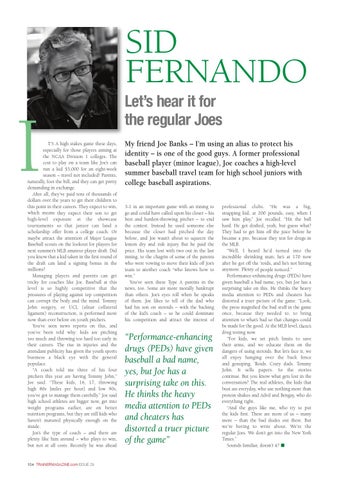FERNANDO NA ISSUE 29_Jerkins feature.qxd 25/07/2013 13:32 Page 1
SID FERNANDO
I
T’S A high stakes game these days, especially for those players aiming at the NCAA Division 1 colleges. The cost to play on a team like Joe’s can run a kid $5,000 for an eight-week season – travel not included! Parents, naturally, foot the bill, and they can get pretty demanding in exchange. After all, they’ve paid tens of thousands of dollars over the years to get their children to this point in their careers. They expect to win, which means they expect their son to get high-level exposure at the showcase tournaments so that junior can land a scholarship offer from a college coach. Or maybe attract the attention of Major League Baseball scouts on the lookout for players for next summer’s MLB amateur player draft. Did you know that a kid taken in the first round of the draft can land a signing bonus in the millions? Managing players and parents can get tricky for coaches like Joe. Baseball at this level is so highly competitive that the pressures of playing against top competition can corrupt the body and the mind. Tommy John surgery, or UCL (ulnar collateral ligament) reconstruction, is performed more now than ever before on youth pitchers. You’ve seen news reports on this, and you’ve been told why: kids are pitching too much and throwing too hard too early in their careers. The rise in injuries and the attendant publicity has given the youth sports business a black eye with the general populace. “A coach told me three of his four pitchers this year are having Tommy John,” Joe said. “These kids, 16, 17, throwing high 80s [miles per hour] and low 90s, you’ve got to manage them carefully.” Joe said high school athletes are bigger now, get into weight programs earlier, are on better nutrition programs, but they are still kids who haven’t matured physically enough on the inside. Joe’s the type of coach – and there are plenty like him around – who plays to win, but not at all costs. Recently he was ahead
104 TRAINERMAGAZINE.com ISSUE 29
Let’s hear it for the regular Joes My friend Joe Banks – I’m using an alias to protect his identity – is one of the good guys. A former professional baseball player (minor league), Joe coaches a high-level summer baseball travel team for high school juniors with college baseball aspirations. 3-1 in an important game with an inning to go and could have called upon his closer – his best and hardest-throwing pitcher – to end the contest. Instead he used someone else because the closer had pitched the day before, and Joe wasn’t about to squeeze the lemon dry and risk injury. But he paid the price. His team lost with two out in the last inning, to the chagrin of some of the parents who were vowing to move their kids off Joe’s team to another coach “who knows how to win.” You’ve seen these Type A parents in the news, too. Some are more morally bankrupt than others. Joe’s eyes roll when he speaks of them. Joe likes to tell of the dad who had his son on steroids – with the backing of the kid’s coach – so he could dominate his competition and attract the interest of
“Performance-enhancing drugs (PEDs) have given baseball a bad name, yes, but Joe has a surprising take on this. He thinks the heavy media attention to PEDs and cheaters has distorted a truer picture of the game”
professional clubs. “He was a big, strapping kid, at 200 pounds, easy, when I saw him play,” Joe recalled. “Hit the ball hard. He got drafted, yeah, but guess what? They had to get him off the juice before he became a pro, because they test for drugs in the MLB. “Well, I heard he’d turned into the incredible shrinking man; he’s at 170 now after he got off the ’roids, and he’s not hitting anymore. Plenty of people noticed.” Performance-enhancing drugs (PEDs) have given baseball a bad name, yes, but Joe has a surprising take on this. He thinks the heavy media attention to PEDs and cheaters has distorted a truer picture of the game. “Look, the press magnified the bad stuff in the game once, because they needed to, to bring attention to what’s bad so that changes could be made for the good. At the MLB level, there’s drug testing now. “For kids, we set pitch limits to save their arms, and we educate them on the dangers of using steroids. But let’s face it, we all enjoy hanging over the back fence and gossiping. ’Roids. Crazy dads. Tommy John. It sells papers. So the stories continue. But you know what gets lost in the conversation? The real athletes, the kids that bust ass everyday, who use nothing more than protein shakes and Advil and Bengay, who do everything right. “And the guys like me, who try to put the kids first. There are more of us – many more – than the bad dudes out there. But we’re boring to write about. We’re the regular Joes. We don’t get into the New York Times.” Sounds familiar, doesn’t it? n
